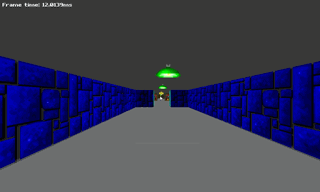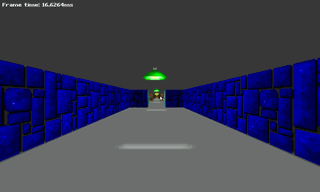I'm writing a clone of Wolfenstein 3D using only core OpenGL 3.3 for university and I've run into a bit of a problem with the sprites, namely getting them to scale correctly based on distance.
From what I can tell, previous versions of OGL would in fact do this for you, but that functionality has been removed, and all my attempts to reimplement it have resulted in complete failure.
My current implementation is passable at distances, not too shabby at mid range and bizzare at close range.
The main problem (I think) is that I have no understanding of the maths I'm using.
The target size of the sprite is slightly bigger than the viewport, so it should 'go out of the picture' as you get right up to it, but it doesn't. It gets smaller, and that's confusing me a lot.
I recorded a small video of this, in case words are not enough. (Mine is on the right)


Can anyone direct me to where I'm going wrong, and explain why?
Code:
C++
// setup
glPointParameteri(GL_POINT_SPRITE_COORD_ORIGIN, GL_LOWER_LEFT);
glEnable(GL_PROGRAM_POINT_SIZE);
// Drawing
glUseProgram(StaticsProg);
glBindVertexArray(statixVAO);
glUniformMatrix4fv(uStatixMVP, 1, GL_FALSE, glm::value_ptr(MVP));
glDrawArrays(GL_POINTS, 0, iNumSprites);
Vertex Shader
#version 330 core
layout(location = 0) in vec2 pos;
layout(location = 1) in int spriteNum_;
flat out int spriteNum;
uniform mat4 MVP;
const float constAtten = 0.9;
const float linearAtten = 0.6;
const float quadAtten = 0.001;
void main() {
spriteNum = spriteNum_;
gl_Position = MVP * vec4(pos.x + 1, pos.y, 0.5, 1); // Note: I have fiddled the MVP so that z is height rather than depth, since this is how I learned my vectors.
float dist = distance(gl_Position, vec4(0,0,0,1));
float attn = constAtten / ((1 + linearAtten * dist) * (1 + quadAtten * dist * dist));
gl_PointSize = 768.0 * attn;
}
Fragment Shader
#version 330 core
flat in int spriteNum;
out vec4 color;
uniform sampler2DArray Sprites;
void main() {
color = texture(Sprites, vec3(gl_PointCoord.s, gl_PointCoord.t, spriteNum));
if (color.a < 0.2)
discard;
}
First of all, I don't really understand why you use pos.x + 1.
Next, like Nathan said, you shouldn't use the clip-space point, but the eye-space point. This means you only use the modelview-transformed point (without projection) to compute the distance.
uniform mat4 MV; //modelview matrix
vec3 eyePos = MV * vec4(pos.x, pos.y, 0.5, 1);
Furthermore I don't completely understand your attenuation computation. At the moment a higher constAtten value means less attenuation. Why don't you just use the model that OpenGL's deprecated point parameters used:
float dist = length(eyePos); //since the distance to (0,0,0) is just the length
float attn = inversesqrt(constAtten + linearAtten*dist + quadAtten*dist*dist);
EDIT: But in general I think this attenuation model is not a good way, because often you just want the sprite to keep its object space size, which you have quite to fiddle with the attenuation factors to achieve that I think.
A better way is to input its object space size and just compute the screen space size in pixels (which is what gl_PointSize actually is) based on that using the current view and projection setup:
uniform mat4 MV; //modelview matrix
uniform mat4 P; //projection matrix
uniform float spriteWidth; //object space width of sprite (maybe an per-vertex in)
uniform float screenWidth; //screen width in pixels
vec4 eyePos = MV * vec4(pos.x, pos.y, 0.5, 1);
vec4 projCorner = P * vec4(0.5*spriteWidth, 0.5*spriteWidth, eyePos.z, eyePos.w);
gl_PointSize = screenWidth * projCorner.x / projCorner.w;
gl_Position = P * eyePos;
This way the sprite always gets the size it would have when rendered as a textured quad with a width of spriteWidth.
EDIT: Of course you also should keep in mind the limitations of point sprites. A point sprite is clipped based of its center position. This means when its center moves out of the screen, the whole sprite disappears. With large sprites (like in your case, I think) this might really be a problem.
Therefore I would rather suggest you to use simple textured quads. This way you circumvent this whole attenuation problem, as the quads are just transformed like every other 3d object. You only need to implement the rotation toward the viewer, which can either be done on the CPU or in the vertex shader.
Based on Christian Rau's answer (last edit), I implemented a geometry shader that builds a billboard in ViewSpace, which seems to solve all my problems:


Here are the shaders: (Note that I have fixed the alignment issue that required the original shader to add 1 to x)
Vertex Shader
#version 330 core
layout (location = 0) in vec4 gridPos;
layout (location = 1) in int spriteNum_in;
flat out int spriteNum;
// simple pass-thru to the geometry generator
void main() {
gl_Position = gridPos;
spriteNum = spriteNum_in;
}
Geometry Shader
#version 330 core
layout (points) in;
layout (triangle_strip, max_vertices = 4) out;
flat in int spriteNum[];
smooth out vec3 stp;
uniform mat4 Projection;
uniform mat4 View;
void main() {
// Put us into screen space.
vec4 pos = View * gl_in[0].gl_Position;
int snum = spriteNum[0];
// Bottom left corner
gl_Position = pos;
gl_Position.x += 0.5;
gl_Position = Projection * gl_Position;
stp = vec3(0, 0, snum);
EmitVertex();
// Top left corner
gl_Position = pos;
gl_Position.x += 0.5;
gl_Position.y += 1;
gl_Position = Projection * gl_Position;
stp = vec3(0, 1, snum);
EmitVertex();
// Bottom right corner
gl_Position = pos;
gl_Position.x -= 0.5;
gl_Position = Projection * gl_Position;
stp = vec3(1, 0, snum);
EmitVertex();
// Top right corner
gl_Position = pos;
gl_Position.x -= 0.5;
gl_Position.y += 1;
gl_Position = Projection * gl_Position;
stp = vec3(1, 1, snum);
EmitVertex();
EndPrimitive();
}
Fragment Shader
#version 330 core
smooth in vec3 stp;
out vec4 colour;
uniform sampler2DArray Sprites;
void main() {
colour = texture(Sprites, stp);
if (colour.a < 0.2)
discard;
}
If you love us? You can donate to us via Paypal or buy me a coffee so we can maintain and grow! Thank you!
Donate Us With